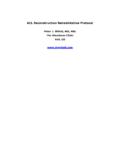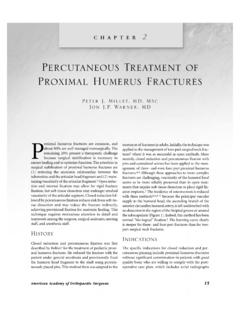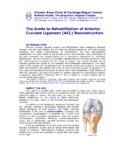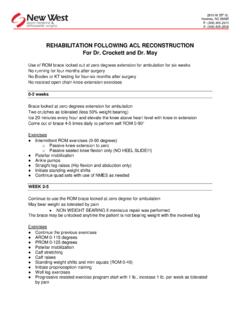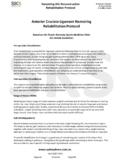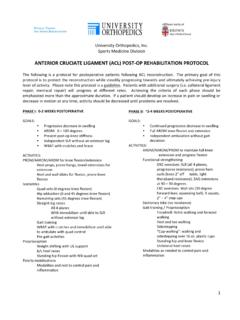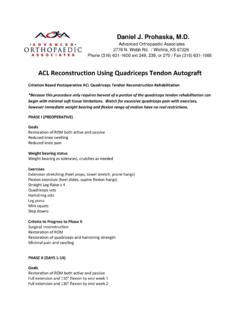Transcription of ACL Reconstruction Rehabilitation Protocol - drmillett.com
1 ACL Reconstruction Rehabilitation Protocol Peter J. Millett, MD, MSc The Steadman Clinic Vail, CO. ACL Reconstruction Rehabilitation Protocol Table of Contents Preoperative Rehabilitation Understanding Surgery ..7. Postoperative Days 1 - 7 ..8. Postoperative Days 8 - 10 .. 12. Postoperative Week 2 .. 13. Postoperative Weeks 3 - 16. Postoperative Weeks 4 - 17. Postoperative Weeks 6 12 .. 17. Postoperative Weeks 12 18. 24 Weeks Postoperative (6 months) .. 18. Medication Regimen .. 18. List of Figures Figure 1. Heel prop using a rolled towel..4. Figure 2. Prone Hang. Note the knee is off the edge of the table..4. Figure 3. Wall Slide: Allow the knee to gently slide Figure 4. Heel slide leg is pulled toward the buttocks ..5. Figure 5. Heel slides in later stages of Rehabilitation ..5. Figure 6. Stationary Bicycle helps to increase Figure 7. Use the non-injured leg to straighten the knee.
2 10. Figure 8. Passive Flexion allowing gravity to bend the knee to 90 degrees .. 10. Figure 9. Straight leg raises lying (left) and seated (right) .. 11. Figure 10. Partial squat using Table for stabilization .. 13. Figure 11. Toe Raise .. 14. Figure 12. Leg press using 90-0 degree range .. 16. -2- Peter J. Millett, MD, MSc Sports Medicine and Orthopaedic Surgery ACL Reconstruction Rehabilitation Protocol One of the most common complications following ACL Reconstruction is loss of motion, especially loss of extension. Loss of knee extension has been shown to result in a limp, quadriceps muscle weakness, and anterior knee pain. Studies have demonstrated that the timing of ACL surgery has a significant influence on the development of postoperative knee stiffness. THE HIGHEST INCIDENCE OF KNEE STIFFNESS OCCURS IF ACL SURGERY IS PERFORMED. WHEN THE KNEE IS SWOLLEN, PAINFUL, AND HAS A LIMITED RANGE OF MOTION.
3 The risk of developing a stiff knee after surgery can be significantly reduced if the surgery is delayed until the acute inflammatory phase has passed, the swelling has subsided, a normal or near normal range of motion (especially extension) has been obtained, and a normal gait pattern has been reestablished. Preoperative Rehabilitation Phase Prepare for surgery using the information within this section. Goals: * Control pain and swelling * Restore normal range of motion * Develop muscle strength sufficient for normal gait and ADL. * Mentally prepare the patient for surgery Before proceeding with surgery the acutely injured knee should be in a quiescent state with little or no swelling, have a full range of motion, and the patient should have a normal or near normal gait pattern. More important than a predetermined time before performing surgery is the condition of the knee at the time of surgery.
4 Use the following guidelines to prepare the knee for surgery: Immobilize the knee Following the acute injury you should use a knee immobilizer and crutches until you regain good muscular control of the leg. Extended use of the knee immobilizer should be limited to avoid quadriceps atrophy. You are encouraged to bear as much weight on the leg as is comfortable. Control Pain and Swelling Icing along with nonsteroidal anti-inflammatory medications such as Advil, Nuprin, Motrin, Ibuprofen, Aleve (2 tablets twice a day) are used to help control pain and swelling. The nonsteroidal anti-inflammatory medications are continued for 7 - 10 days following the acute injury. -3- ACL Reconstruction Rehabilitation Protocol Restore normal range of motion You should attempt to achieve full range of motion as quickly as possible. Quadriceps isometrics exercises, straight leg raises, and range of motion exercises should be started immediately.
5 Full extension is obtained by doing the following exercises: 1) Passive knee extension. Sit in a chair and place your heel on the edge of a stool or chair. Relax the thigh muscles. Let the knee sag under it's own weight until maximum extension is achieved. 2) Heel Props: Place the heel on a rolled towel making sure the heel is propped high enough to lift the thigh off the table. Allow the leg to relax into extension. 3 - 4 times a day for 10 - 15 minutes at a time. See Figure 1. Figure 1. Heel prop using a rolled towel. 3) Prone hang exercise. Lie face down on a table with the legs hanging off the edge of the table. Allow the legs to sag into full extension. Figure 2. Prone Hang. Note the knee is off the edge of the table. -4- Peter J. Millett, MD, MSc Sports Medicine and Orthopaedic Surgery Bending (Flexion) is obtained by doing the following exercises: 1) Passive knee bend Sit on the edge of a table and let the knee bend under the influence of gravity.
6 2) Wall slides are used to further increase bending. Lie on the back with the involved foot on the wall and allow the foot to slide down the wall by bending the knee. Use other leg to apply pressure downward. Figure 3. Wall Slide: Allow the knee to gently slide down 3) Heel slides are used to gain final degrees of flexion. Pull the heel toward the buttocks, flexing the knee. Hold for 5 seconds. Straighten the leg by sliding the heel downward and hold for 5 seconds. Figure 4. Heel slide leg is pulled toward the buttocks In later stages of Rehabilitation , do heel slides by grasping the leg with both hands and pulling the heel toward the buttocks. Figure 5. Heel slides in later stages of Rehabilitation -5- ACL Reconstruction Rehabilitation Protocol Develop muscle strength Once 100 degrees of flexion (bending) has been achieved you may begin to work on muscular strength: 1) Stationary Bicycle.
7 Use a stationary bicycle two times a day for 10 - 20 minutes to help increase muscular strength, endurance, and maintain range of motion. See Figure 6. Figure 6. Stationary Bicycle helps to increase strength 2) Swimming is also another exercise that can be done during this phase to develop muscle strength and maintain your range of motion. 3) Low impact exercise machines such as an elliptical cross-trainer, leg press machine, leg curl machine, and treadmill can also be used. This program should continue until you have achieved a full range of motion and good muscular control of the leg (you should be able to walk without a limp). Mentally prepare Understand what to realistically expect of the surgery Make arrangements with a physical therapist for post-operative Rehabilitation Make arrangements with your place of employment. Make arrangements with family and/or friends to help during the post-operative Rehabilitation Read and understand the Rehabilitation phases after surgery -6- Peter J.
8 Millett, MD, MSc Sports Medicine and Orthopaedic Surgery Understanding Surgery This section provides an understanding of the pre and post-operative phases of surgery. Key terms: Pain control, Drainage tube, Cryocuff, Knee Immobilizer, TED. Stocking Before Surgery Prior to beginning the operation and at the conclusion of the operation, a solution containing a long acting local anesthetic Marcaine will be injected into your knee. This solution will block the pain nerve fibers and local pain receptors in your knee. Recent studies have shown that this is a safe and effective way to control pain after knee surgery. In many cases the injection will last 12 or more hours after surgery and significantly reduce the amount of pain medication that you will have to take. After Surgery Prior to leaving the operating room a knee immobilizer and an ice machine will be applied to your knee.
9 The GameReady ice machine will provide cold and compression, reducing pain and swelling. This unit should be used continuously for the first 3 - 4 days after your surgery. After this time period the Game Ready can be used as needed for comfort. The Game Ready should be used for approximately 30 minutes, with 30. minutes between sessions. The postoperative knee brace helps to maintain extension and is to be worn at all times while walking and during sleeping, Otherwise it can be removed. After surgery, your leg will be wrapped in soft cotton bandage. You can slide the bandage down to change the dressings as needed. After the anesthesia has worn off, your vital signs are stable and your pain is under control you will be discharged from the hospital or surgical center. You will not be allowed to drive a car. Therefore prior to your discharge, you must arrange for transportation.
10 -7- ACL Reconstruction Rehabilitation Protocol Postoperative Days 1 - 7. Follow the guidelines within this section for the first seven days after your surgery IT IS EXTREMELY IMPORTANT THAT YOU WORK ON EXTENSION IMMEDIATELY. Goals: * Control pain and swelling * Care for the knee and dressing * Early range of motion exercises * Achieve and maintain full passive extension * Prevent shutdown of the quadriceps muscles * Gait training Control Pain and Swelling 1) Control Swelling. Following discharge from the hospital you should go home elevate your leg and keep the knee iced using the GameReady cooling unit. You may get up to use the bathroom and eat, but otherwise you should rest with your leg elevated. 2) Do not sit for long periods of time with your foot in a dependent position (lower than the rest of your body), as this will cause increased swelling in your knee and leg. When sitting for any significant period of time, elevate your leg and foot.
